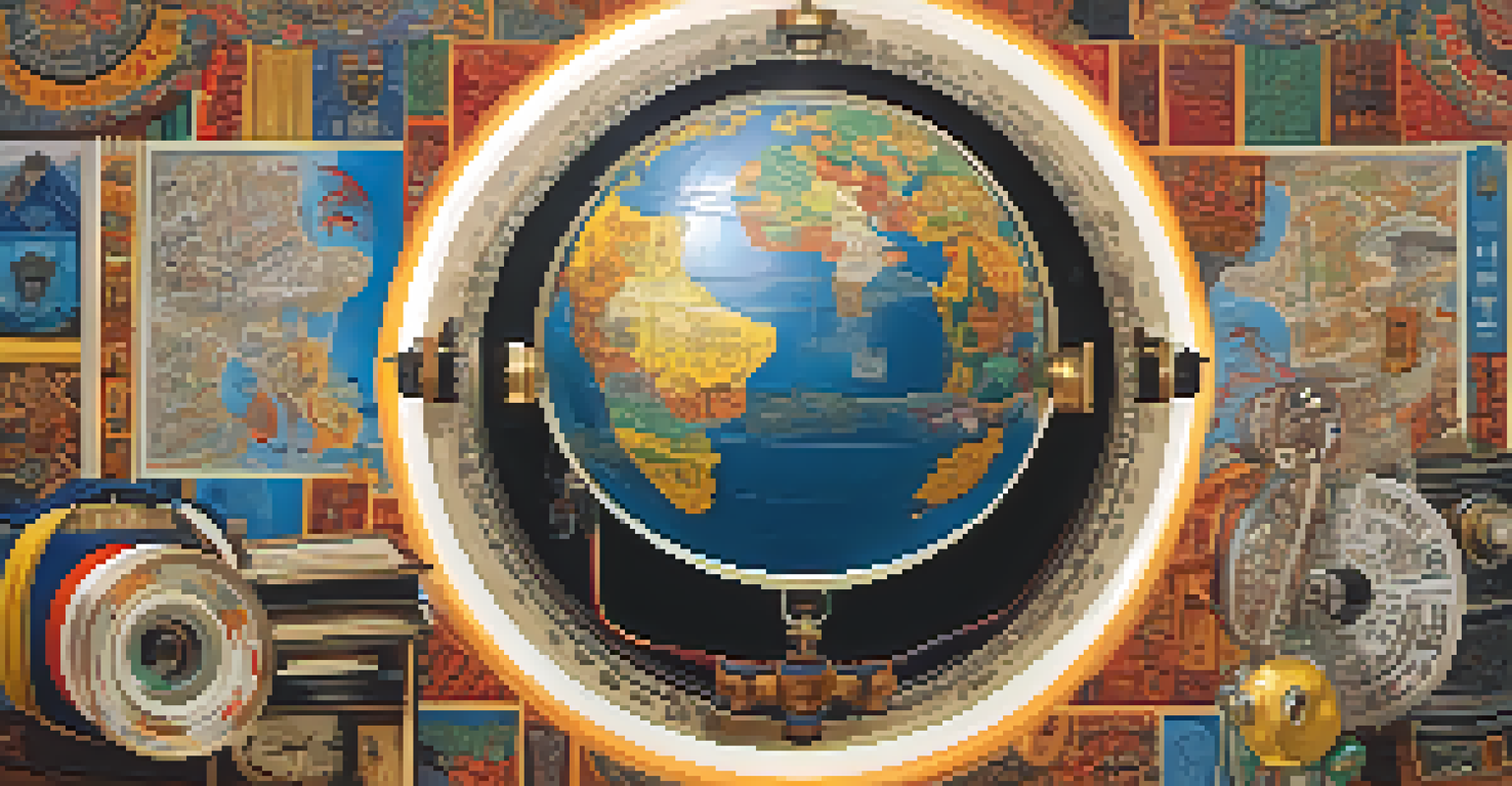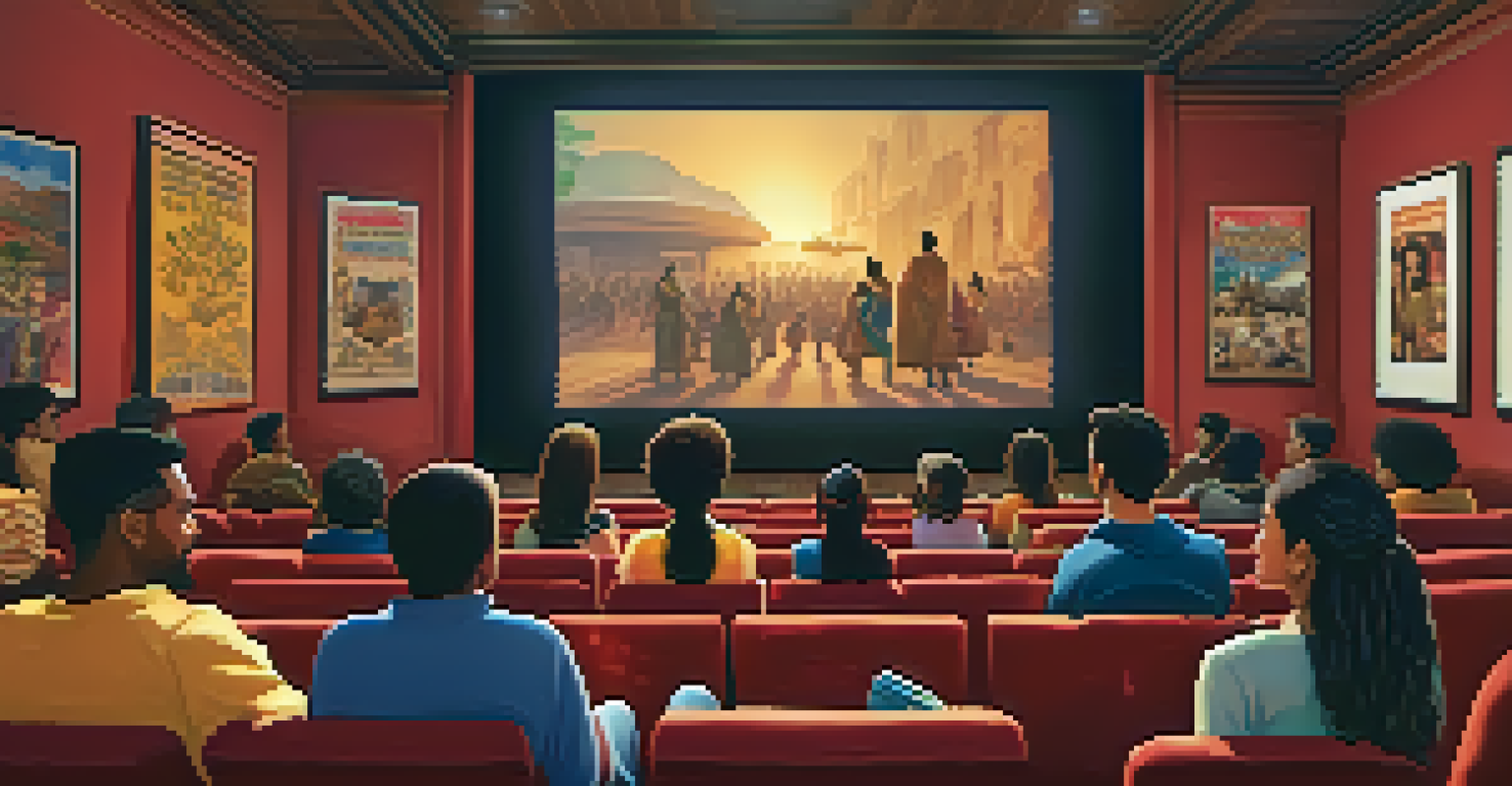How Hollywood Portrays Different Societies and Cultures

The Power of Representation in Film and Television
Representation matters, especially in film and television. Hollywood has the unique ability to shape perceptions about different societies and cultures through storytelling. When diverse characters are portrayed authentically, it challenges stereotypes and fosters understanding.
The only way to make sense out of change is to plunge into it, move with it, and join the dance.
On the flip side, when representation is lacking or poorly executed, it can perpetuate harmful stereotypes. For instance, the portrayal of certain ethnic groups as villains can lead to real-world biases. Thus, filmmakers hold a significant responsibility to depict cultures with nuance and respect.
Moreover, successful representation can open doors for underrepresented communities in the industry. When diverse stories are told, it not only enriches the narrative landscape but also encourages diverse talent to step into the limelight.
Stereotypes and Their Impact on Public Perception
Stereotypes in Hollywood are often oversimplified and can be damaging. For example, the 'model minority' myth surrounding Asian cultures often overlooks the diversity within these communities. When films rely on such clichés, they can misinform audiences and reinforce narrow viewpoints.

These stereotypes can have real-world consequences. They influence how people from different backgrounds are treated in society, often leading to discrimination or misunderstanding. It’s essential for filmmakers to recognize the weight their narratives carry and strive for accuracy.
Importance of Authentic Representation
Authentic representation in film and television challenges stereotypes and fosters understanding among diverse cultures.
However, some modern films are beginning to challenge these stereotypes effectively. By showcasing complex characters and varied experiences, they help audiences see beyond the shallow representations, paving the way for richer dialogues about race and identity.
Cultural Appropriation vs. Appreciation in Film
Cultural appropriation in Hollywood is a contentious issue. It occurs when elements of one culture are used by another, often without proper understanding or respect. An example can be seen in films that borrow traditional clothing or symbols but fail to reflect the culture’s significance.
Diversity is not a reason for division, but rather a reason for unity.
On the other hand, cultural appreciation involves a respectful engagement with another culture. Films that seek collaboration with cultural consultants and feature authentic voices can celebrate diversity. For instance, Disney’s 'Moana' received praise for its efforts to honor Polynesian culture through consultation.
Navigating the line between appropriation and appreciation is vital for filmmakers today. By prioritizing authenticity and collaboration, Hollywood can create stories that celebrate cultures rather than exploit them.
The Role of Storytelling in Cultural Exchange
Storytelling is a powerful tool for cultural exchange. Through films, audiences can explore different ways of life, traditions, and values. Movies like 'The Kite Runner' provide insights into Afghan culture, promoting empathy and understanding among viewers who may have never encountered it otherwise.
Moreover, storytelling can bridge gaps between cultures. When stories resonate beyond their cultural origins, they highlight common human experiences, creating connections. This universal appeal can foster dialogue and appreciation across diverse audiences.
Cultural Appropriation vs. Appreciation
Navigating between cultural appropriation and appreciation is crucial for filmmakers to create respectful and authentic narratives.
However, it's crucial for these stories to be told authentically. When filmmakers respect the source material and collaborate with cultural representatives, they enhance the richness of the narrative while avoiding cultural inaccuracies.
Influence of Globalization on Hollywood Narratives
Globalization has significantly impacted Hollywood's storytelling landscape. As audiences around the world consume media, filmmakers are increasingly aware of the need for diverse narratives that resonate globally. This shift has led to a wider variety of stories being told, reflecting a more interconnected world.
Films like 'Black Panther' and 'Parasite' have achieved international acclaim, showcasing the potential for diverse stories to resonate across borders. These films not only entertain but also provide commentary on societal issues, allowing audiences to engage with cultural themes that are both local and universal.
However, as Hollywood embraces globalization, it must also remain vigilant about authenticity. Striking a balance between appealing to global audiences while respecting local cultures is essential for future storytelling.
The Impact of Technology on Cultural Representation
Technology has transformed how stories are told and shared, affecting cultural representation in Hollywood. Streaming platforms allow for a wider variety of voices and stories to reach global audiences, breaking the traditional barriers of film distribution. This democratization of content creation has led to more diverse narratives emerging from various cultures.
Additionally, advancements in CGI and animation have enabled filmmakers to depict fantastical elements of different cultures in ways that were previously unimaginable. Films like 'Coco' celebrate Mexican traditions with vibrant visuals, captivating audiences while honoring cultural heritage.
Future Demands for Diverse Narratives
The future of Hollywood hinges on embracing diversity and inclusivity, as audiences increasingly seek genuine cultural representations.
However, with great power comes great responsibility. Filmmakers must use technology mindfully, ensuring that the stories they tell do justice to the cultures they represent, rather than reducing them to mere spectacle.
The Future of Cultural Representation in Hollywood
As we look to the future, the conversation around cultural representation in Hollywood continues to evolve. There is a growing demand for authenticity and inclusivity in storytelling, with audiences increasingly advocating for diverse perspectives. This shift indicates a positive trend towards more nuanced portrayals of different societies.
Moreover, the rise of independent films and diverse filmmakers is contributing to this change. With new voices entering the industry, we can expect a richer tapestry of stories that reflect the complexity of our world. Films that prioritize representation will likely resonate more with audiences who seek genuine connections.

Ultimately, the future of Hollywood’s portrayal of cultures hinges on its willingness to listen, learn, and adapt. By embracing diversity and fostering inclusive storytelling, Hollywood can continue to be a powerful platform for cultural exchange and understanding.